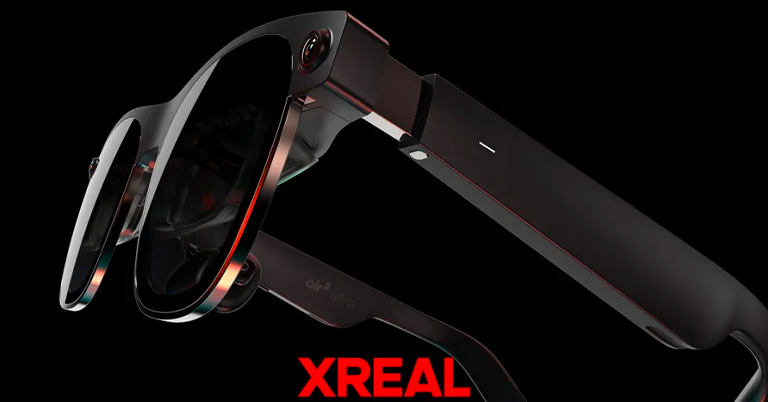
Xreal (formerly Nreal), a company known for its AR and Mixed reality glasses, recently unveiled its latest offering – Xreal Air 2 Ultra. And it brings a lot of cool features like 6 DoF (Degrees of Freedom), spatial and hand tracking, high-resolution screens, and a wider 52-degree field of view. In this article, let’s take a quick look at the Xreal Air 2 Ultra, its features, improvements, expected price in Nepal, and availability.
Xreal Air 2 Ultra Overview:
Spatial Tracking
One of the highlight features of the Air 2 Ultra is its 6 DOF and spatial tracking. Thanks to the 3D sensors on the front, the glasses can now scan your environment and project digital elements over the physical world. It can also read your hand movements and gestures to keep track of your interactions. And if you were confused about the degree of freedom (DoF) shenanigans, it simply means that you can not only move your head (side to side / up and down/ tilt) in a virtual space but also move around (left/right, forward/backward) in it.
This is in fact not Xreal’s first rodeo when it comes to 6 DoF, as its Nreal Light glasses, announced back in 2021, boast the same. So, in a way, the Air 2 Ultra is a successor to the revered Nreal Light.

Design and Display
Following the norm, the new Air 2 Ultra looks like a typical pair of sunglasses just like the Xreal Air 2 and Air 2 Pro. That’s if you don’t notice its pair of environmental sensors on the front. It’s also a bit heavy for a pair of sunglasses at 80 grams and around 10% heavier than the Air 2. But, the Air 2 Ultra features a titanium frame and looks sleeker and more stylish as well.
Talking about the display, the Air 2 Ultra sees a bit of an upgrade here. Now, you have a wider 52-degree field of view over the 46 degrees on previous models. It also functions a whole lot differently with the 6 DoF and spatial hand tracking we talked about earlier. Besides that though, Air 2 Ultra still has the same Sony Micro-OLED screens at 1080p resolution for each eye. It can reach 120Hz in terms of refresh rate and hits 500 nits of max brightness. They also have TUV Rheinland certification for color accuracy, eye comfort, low blue light, and zero flicker.
Watching content on the Air 2 Ultra should be very similar to looking at a 154-inch screen at a distance of 13 feet.

Other Features
Just like the Air 2 Pro, there is electrochromic dimming for improved immersion. With “Immersion Control”, you can opt between choosing to see the outside world (0%, 35%) or blocking it completely (100%). There are also directional speakers and dual microphones for audio.
- Also Read:
One thing to note is that the Xreal Air 2 Ultra isn’t a standalone computer. It needs a separate computing unit to function to its fullest and you can connect the glasses to either Samsung’s S22 and S23 or the iPhone 15 series (via USB C) to use spatial computing. You can also use Nebula in Desktop or Mac to do the same but Xreal’s own Beam unit (computing unit for Air 2 and Air 2 Pro) only allows for 3 DoF. The company has, however, mentioned that it’ll be coming up with a custom computing unit for the Air 2 Ultra soon.
Xreal Air 2 Ultra Pricing and Availability
The glasses will be available starting March 2024. They cost USD 699 and aim to directly compete with the Meta Quest 3 ($499) and the upcoming Apple Vision Pro ($ 3,499). Although unlikely, if it makes it here, we expect the Xreal Air 2 Ultra price in Nepal to be around NPR 99,999.
Xreal AR glasses
Price in the US
Price in Nepal (Expected)
Air 2 Ultra
USD 699
NPR 99,999
- Meanwhile, check out our impressions of the Redmi Note 13 Pro.















![Best Gaming Laptops in Nepal 2024 [Updated] Best Gaming Laptops in Nepal 2024 - April Update](https://cdn.gadgetbytenepal.com/wp-content/uploads/2024/04/Best-Gaming-Laptops-in-Nepal-2024.jpg)

![Best Ultrabooks To Buy in Nepal 2024 [Updated] Best Ultrabook Laptops in Nepal 2023 - June Update](https://cdn.gadgetbytenepal.com/wp-content/uploads/2023/04/Best-Ultrabook-Laptops-in-Nepal-2023-June-Update.jpg)
![Best Laptops Under Rs. 80,000 in Nepal [Updated] Best laptops under NPR 80000 in Nepal -2023 Update](https://cdn.gadgetbytenepal.com/wp-content/uploads/2023/10/Best-laptops-under-NPR-80000-in-Nepal-October-2023-Update.jpg)
![Best Laptops Under Rs. 70,000 in Nepal [Updated] Best Laptops Under 70000 in Nepal 2023](https://cdn.gadgetbytenepal.com/wp-content/uploads/2023/01/Best-Laptops-Under-NPR-70000-in-Nepal-February-2023.jpg)
![Best Mobile Phones Under Rs. 15,000 in Nepal [Updated] Best Phones Under 15000 in Nepal 2024 Budget Smartphones Cheap Affordable](https://cdn.gadgetbytenepal.com/wp-content/uploads/2024/03/Best-Phones-Under-15000-in-Nepal-2024.jpg)
![Best Mobile Phones Under Rs. 20,000 in Nepal [Updated] Best Mobile Phones Under NPR 20000 in Nepal 2023 Updated Samsung Xiaomi Redmi POCO Realme Narzo Benco](https://cdn.gadgetbytenepal.com/wp-content/uploads/2024/01/Best-Phones-Under-20000-in-Nepal-2024.jpg)
![Best Mobile Phones Under Rs. 30,000 in Nepal [Updated]](https://cdn.gadgetbytenepal.com/wp-content/uploads/2023/12/Best-Phones-Under-30000-in-Nepal-2024.jpg)
![Best Mobile Phones Under Rs. 40,000 in Nepal [Updated] Best Phones Under 40000 in Nepal 2024 Smartphones Mobile Midrange](https://cdn.gadgetbytenepal.com/wp-content/uploads/2024/02/Best-Phones-Under-40000-in-Nepal-2024.jpg)
![Best Mobile Phones Under Rs. 50,000 in Nepal [Updated] Best Phones Under 50000 in Nepal 2024 Smartphones Midrange](https://cdn.gadgetbytenepal.com/wp-content/uploads/2024/02/Best-Phones-Under-50000-in-Nepal-2024.jpg)
![Best Flagship Smartphones To Buy In Nepal [Updated] Best Smartphones in Nepal 2024 Flagship Premium Samsung Apple iPhone Xiaomi OnePlus Honor](https://cdn.gadgetbytenepal.com/wp-content/uploads/2023/09/Best-Smartphones-in-Nepal-2024.jpg)